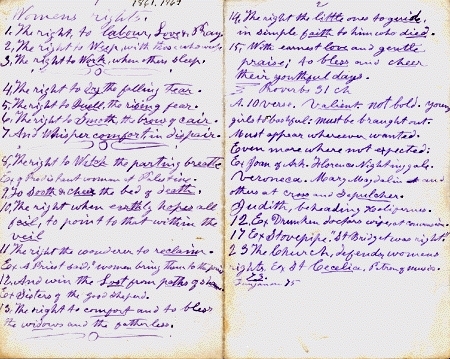Womens Rights
Rev. Lindesmith shared many similar views of his contemporaries about the role and duties of women. Possibly in a response to the Womans Rights Movement, he articulated in a 1861 sermon, “Women's Rights,” that women had the right to love and support their families and guide their children and husbands through a moral life.
Womens rights1. The right to labour, Love & Pray. 2. The right to Weep, with those who weep. 3. The right to Work, when others sleep. 4. The right to dry the falling tears. 5. The right to Quell the rising fear. 6. The right to Smooth the brow of cair. 7. And whisper comfort, in dispair. 8. The right to Watch the parting breathe. Ex. of Proditent woman of Palestine. 9. To soother & cheer the bed of death. 10. The right when earthly hopes all fail, to point to that within the veil. 11. The right of women to reclaim. Ex. A Priest ---- women bring them to the priesthood. 12. And win the Last from paths of shame. Ex. Sisters of the Good Shepherd. 13. The right to comfort and to bless the widows and the fatherless. |
14. The right the little ones to guide. in simple faith to him who died. 15. With earnest love and gentle praise; to bless and cheer their youthful days. Proverbs 31 ch A. 10 verse. Valient not bold, young girls & bashful: must be brought out. Must appear wherever wanted. Even more where not expected: Ex Joan of Arc. Florence Nightingale. Veronica. Mary Magdalin and others at cross and sepulcher. Judith, beheading ------- . 16. Ex. Drunken doctors ------ 17. Ex. Stovepipe. “St. Bridget was right.” 23 The Church, defender of womens rights. Ex. St. Cecilia. Patron of women. |
This view of women was common to both Protestants and Catholics as the cult of domesticity or the elevation of the woman as the center of the home and family life developed throughout the nineteenth century. By the mid to late nineteenth century, women's guardianship of their families expanded to include reform of society. This foray into public life manifested itself in various causes such as temperance reform, benevolent associations, and charitable activities. Middle and upper class Protestant women engaged in reform activities throughout the nineteenth century. Catholic women also sought to guide and reform their families and neighbors, but they did so as women religious. Far fewer single and married Catholic women joined their Protestant contemporaries.

